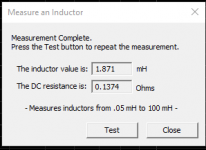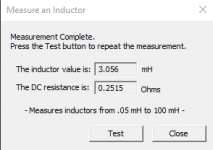Good suggestions above..
The "about 1/3 more is accurate, comes from:
3mH/1.8mH=1.67
Sqrt 1.67=1.29 , so 29% more turns.
Round it up to 30%
As of the wire joint, you don´t really need to twist those wires, just scratch 5 to 10mm enamel from joining ends, tin them and overlap them (put them in contact side by side and run a bead of solder between them.
There is no mechanical stress applied to that joint so "just soldering" is fine, and you save a lot of space.
Heatshrink or tape to insulate, hand applied enamel is not trusty enough.
I do that all the time to use down to the last wire from a spool, or to add taps (same thing but "L" bending the tap wire end soldering it to a short scratched area on main wire)
Real scarce available space on a transformer winding (the whole bobbin must still fit inside the lamination window) and a twisted joint can occupy up to 3 layers thickness, while the one I suggest can stay "flat", plus insulating tape thickness of course.
The "about 1/3 more is accurate, comes from:
3mH/1.8mH=1.67
Sqrt 1.67=1.29 , so 29% more turns.
Round it up to 30%
As of the wire joint, you don´t really need to twist those wires, just scratch 5 to 10mm enamel from joining ends, tin them and overlap them (put them in contact side by side and run a bead of solder between them.
There is no mechanical stress applied to that joint so "just soldering" is fine, and you save a lot of space.
Heatshrink or tape to insulate, hand applied enamel is not trusty enough.
I do that all the time to use down to the last wire from a spool, or to add taps (same thing but "L" bending the tap wire end soldering it to a short scratched area on main wire)
Real scarce available space on a transformer winding (the whole bobbin must still fit inside the lamination window) and a twisted joint can occupy up to 3 layers thickness, while the one I suggest can stay "flat", plus insulating tape thickness of course.
Last edited:
That did it
OK JMFahey's procedure works just fine.
First is the value measured in DATS and 2nd is after soldering the new magnet wire on.
Lojzek suggested 3.7 linear meters based on some kind of wizardry he used to calculate it.
I cut 4 meters and made the joint and shrinked it,then wound it as tight as I could. I was a little over at 3.26 mh, so I just unwrapped it a bit at a time til I had my value.
Done and done.
OK JMFahey's procedure works just fine.
First is the value measured in DATS and 2nd is after soldering the new magnet wire on.
Lojzek suggested 3.7 linear meters based on some kind of wizardry he used to calculate it.
I cut 4 meters and made the joint and shrinked it,then wound it as tight as I could. I was a little over at 3.26 mh, so I just unwrapped it a bit at a time til I had my value.
Done and done.
Attachments
Likely to be successful, ok but a difficult choice nonetheless. Windings are subject to microphonic stresses, they sing along with the music.There is no mechanical stress applied to that joint so "just soldering" is fine, and you save a lot of space.
Hmmm
Allen, how can you tell if you have a singing inductor? Would it be some distortion in the frequency graphs?
Or?
Likely to be successful, ok but a difficult choice nonetheless. Windings are subject to microphonic stresses, they sing along with the music.
Allen, how can you tell if you have a singing inductor? Would it be some distortion in the frequency graphs?
Or?
It is a form of resonance. One place in particular I notice this is with amplifier output transformers. When I load with a resistor instead of a speaker I can hear the music coming from the body of the transformer. Especially when doing sine sweeps.
You want to ensure static and dynamic stability in your coils. You want to be sure you have the correct inductance value with the coil wound firmly and tied with cable ties so it will remain in place, even over time with use. This will also reduce microphonics.
I'm not saying this is essential but just so you know, if there is any doubt you can pot it. This has been done with many hand wound and even machine wound inductors and transformers through history. This means dipping into varnish, wax or pitch for example. These can offer a mix of mechanical stability, damping and practicality of use.
You want to ensure static and dynamic stability in your coils. You want to be sure you have the correct inductance value with the coil wound firmly and tied with cable ties so it will remain in place, even over time with use. This will also reduce microphonics.
I'm not saying this is essential but just so you know, if there is any doubt you can pot it. This has been done with many hand wound and even machine wound inductors and transformers through history. This means dipping into varnish, wax or pitch for example. These can offer a mix of mechanical stability, damping and practicality of use.
Hi everybody.
I have an iron core inductor that currently has a value of 1.8 mh.
I need to change it to 3 mh. The supplier has none in stock and the part would be back ordered til who knows when.
Would it be possible to change the value of this by adding windings or would I be better off to buy another?
I have a DATS v3, so I can test and fine tune.
If this is something anybody has done please tell me what and how.
Thanks!
I think you are better off getting a 3.3 mH and trying that first. I checked just now for the US; Madisound, Meniscus and Parts Express are all showing 3.0 mH in stock. I did not check Solen or PartsConnexion. I'm not sure about shipping charges for you but when I buy smaller items from Solen shipped to the US; the prices are higher but not unreasonable. The cost for shipping does go way up for the larger, heavier, bulkier items such as big woofers, etc.
In some cases; you may not even be able to tell the difference between 3.3 mH and 3.0 mH. It would be better to un-wind a 3.3 mH coil than to add another coil in series with the one you already have. Not only do you have possible mutual inductance coupling with multiple inductors but I would also be concerned the DCR would be higher than if you just used one inductor of the correct value. Some people even do custom coil winding for air core; I think some even do solid core. That way; you can specify any "between" value that is not normally stocked. (I use Meniscus for this all the time but for air core only).
- Home
- Loudspeakers
- Multi-Way
- Inductor value

